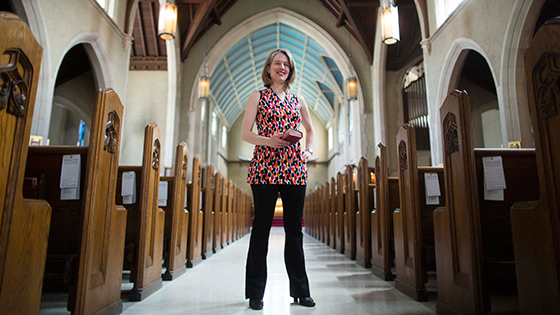Micheline White, whose research focuses primarily on English Renaissance literature and who is currently writing a book on women, religion and politics in Tudor England, came to realize quite by accident that Henry’s last wife, Katherine Parr, served as one of his most important political strategists.
“In spring 2013,” recalls White, “I was on research leave in the U.K. and I was planning to spend two weeks looking at Parr’s first book as part of a different project. No one had ever looked at Parr’s first book carefully before. But I immediately noticed that there were several curious things about it.”
White explains that in 1544, while Henry was at war with the Scots, the French and the Turks, he entrusted Parr to translate and disseminate a volume of wartime prayers to his subjects. The book includes Parr’s translation of Prayer for the King, a new prayer that Henry hoped would secure his military success.
“Parr,” says White, “made fascinating modifications as she translated, and she enhanced Henry’s virtues and his military prowess. It is clear that Parr and Henry collaborated on this piece of political propaganda.”
For example, Parr goes out of her way to heighten Henry’s military strength, honour and glory. “This is because many feared that he would die due to his terrible health. He had an ulcerated leg,” says White.
White has also discerned that the prayer eventually ended up in the Anglican Book of Common Prayer, placed there by Parr’s step-daughter Queen Elizabeth I. When Elizabeth came to power in 1558, she had it edited and renamed A Prayer for the Queen’s Majesty. It was also included in the Book of Common Prayer the following year (issued in June 1559), and then became a permanent part of the Anglican liturgy.
“People were tired of the wars with France and were anxious about having a female queen, so most of the phrases about military glory, honour and ferocity were taken out.”
White explains that what is so surprising is, “It has always been assumed that the Anglican Book of Common Prayer was composed and edited entirely by male clergymen. The discovery shows us that queens had a hand in shaping communal worship, worship that carries on to this day.”
Her discovery is significant when you consider the prayer is still used in Chapels Royal in the United Kingdom to pray for Elizabeth II, and occasionally in Anglican churches around the world.
White says her revelation has piqued the interest and enthusiasm of royal chaplains and bishops of the Church of England. The Bishop of Sherbourne tweeted about White’s article about her discovery after it appeared in the Times Literary Supplement on April 3.
She spent two full years piecing the entire story together. She visited rare book rooms around the U.K. and the Chapel Royal in the Tower of London and looked at privately owned copies of Parr’s book, including a copy owned by Sir William and Lady Meredith Proby of Elton Hall, a partly Gothic house north of London that has been in the Proby family since the mid-17th century.
“It is very rewarding,” White admits, “to undertake difficult archival research about a 16th-century text that is still a living document with contemporary significance. The fact that Anglicans today care about this discovery makes it all worthwhile.”
